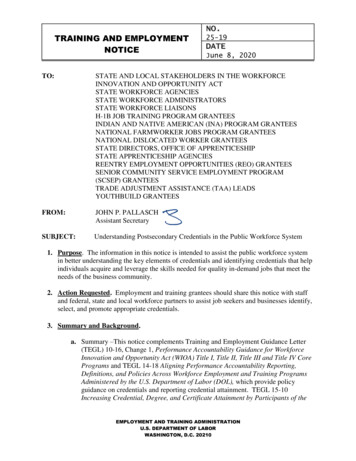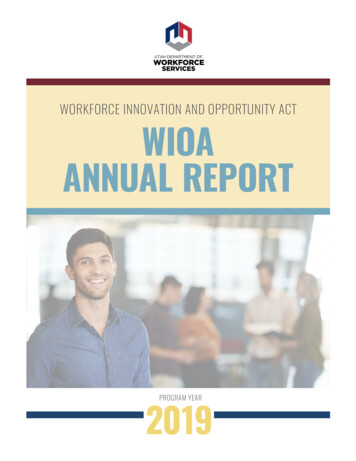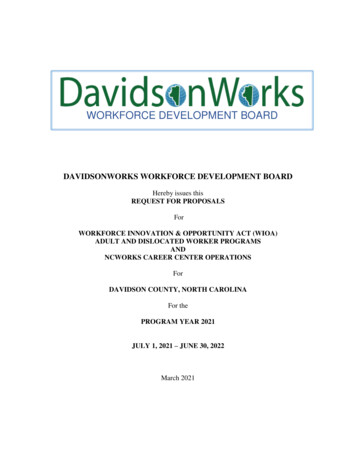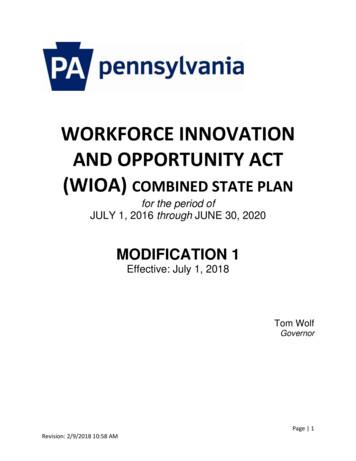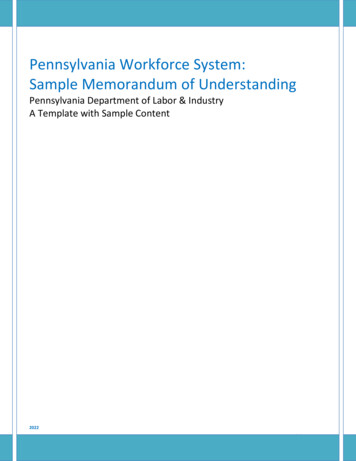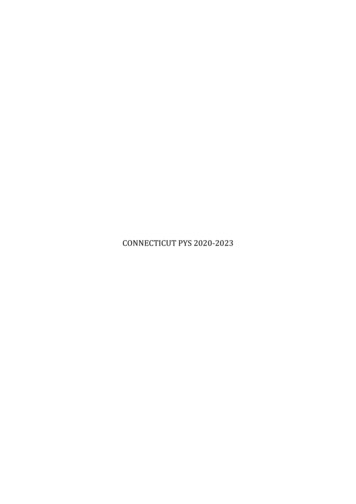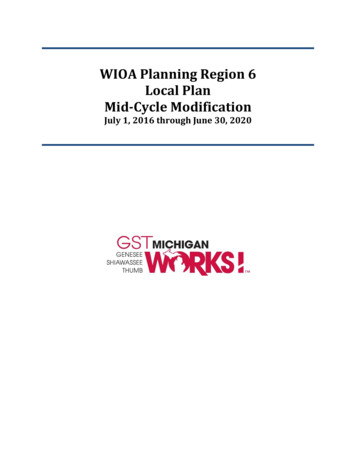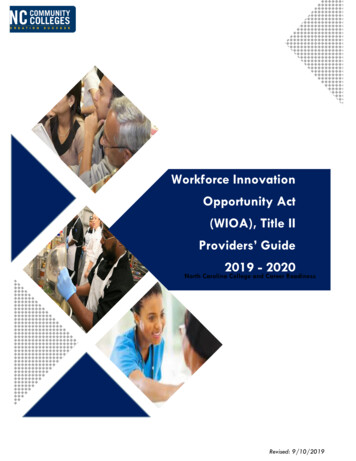
Transcription
Workforce InnovationOpportunity Act(WIOA), Title IIProviders’ Guide2019 - 2020North Carolina College and Career ReadinessRevised: 9/10/2019
Table of ContentsINTRODUCTION. 3Major Points . 4WIOA Highlights . 5Comprehensive American Job Center/ NCWorks Participation . 7TITLE II: ADULT EDUCATION AND FAMILY LITERACY ACT . 9AND FISCAL POLICIES . 9Major Points . 9Title II - Adult Education and Family Literacy Act Overview . 10Allowable Activities. 10Title II- Grant Funding . 12Thirteen Considerations for WIOA TITLE II . 15TITLE II Competitive Funding Process . 16Post Allocation Budget. 16Fiscal Responsibilities . 17Funding Disbursement And Expenditures . 17Allowable Uses Of Federal Funds . 18Unexpended Funds . 19Time and Effort Reporting . 19Risk Assessment . 23Fiscal Audits . 24STUDENT ELIGIBILITY, ENROLLMENT, AND ATTENDANCE . 25Major Points . 25Student Eligibility . 25Enrollment of Special Populations . 26Minors. 26Enrollment of Foreign-born Students . 27Enrollment of Court-ordered Youth . 27Participants versus Reportable Individuals . 28Intake . 29Documenting and Reporting Student Attendance Hours . 29Academic and Career Advising, Support Services . 29CAREER PATHWAYS AND INSTRUCTIONAL PROGRAMMING . 30Major Points . 30Career Pathways. 31Primary Program Areas . 32Instructional Offerings . 32ASSESSMENT . 34Major Points . 34Need for Assessment Policy. 341 Page
INSTRUCTIONAL DELIVERY . 36Major Points . 36Standards-Based Instruction . 36Contextualized Instruction . 37Instructional Delivery Models . 37Integration of Technology . 38Course Scheduling . 38PERFORMANCE AND ACCOUNTABILITY . 39Major Points . 39National Reporting System . 40WIOA Primary Indicators of Performance . 40WIOA Periods Of Participation, Measurable Skill Gains, and Credential Attainment . 41Periods of Participation (POP) . 41Measurable Skill Gains (MSG) . 43Credential Attainment Indicator. 44Literacy Education Information System (LEIS) . 45Performance Reports . 46Records Retention . 46PERSONNEL . 47Major Points . 47Teaching Certification. 47Allowable Costs for TITLE II Personnel . 48Payment for non-Teaching Hours . 48NRS Reporting of TITLE II Personnel . 48PROFESSIONAL DEVELOPMENT (PD) . 50Major Points . 50PD Budget Requirements . 51NCCCS Professional Development System . 51LINCS: A National PD Resource. 51NCCCS Credentialing Courses . 52Local PD Planning . 52Required Trainings . 52GED , HISET , & TASC Testing. 53GLOSSARY OF TERMS . 542 Page
INTRODUCTIONOn July 22, 2014, President Obama signed into law the Workforce Innovation and Opportunity Act(WIOA), which revises and reauthorizes the Workforce Investment Act (WIA) of 1998. WIOA is designedto help job seekers access employment, education, training, and support services to succeed in the labormarket and to match employers with the skilled workers they need to compete in the global economy. Thelaw brings together, in strategic coordination, four primary Titles with six core programs or partners: Title I, Workforce Development Activities, is comprised of three core programs: the Adult, Youth, andDislocated Worker programs, and is administered by the NC Department of Commerce, Division ofWorkforce Solutions;Title II is Adult Education and Literacy and is administered by the North Carolina Community CollegeSystem;Title III is the Wagner-Peyser Act and is administered by the NC Department of Commerce, Divisionof Workforce Solutions; and,Title IV, Vocational Rehabilitation, or the Rehabilitation Act of 1973, is administered by the NCDepartment of Health and Human Services, Division of Vocational Rehabilitation Services.The bipartisan Workforce Innovation and Opportunity Act (WIOA) (Pub. L. 113-128) creates a newvision for how America prepares an educated and skilled workforce that expands opportunity forworkers and employers. WIOA represents the most significant reform to our public workforcedevelopment system in nearly 20 years. The 21stcentury public workforce development systemIn North Carolina, WIOA, Title IIcreated through WIOA builds closer ties betweenis administered by the Northbusiness leaders, State and Local WorkforceCarolina Community CollegeSystem(NCCCS) through aDevelopment Boards, labor unions, communitycompetitive application process.colleges, nonprofit organizations, youth-servingThe program is housed in theorganizations, and State and local officials. ItCollege and Career Readinesssupports the development of strong regionalunit within the NCCCS Officelocated in Raleigh, NC.economies and enhances performanceaccountability to better inform consumers andinvestors about programs and services that work.WIOA establishes ambitious goals for the integration of workforce service programs. These goals areintended to maximize the value and benefits to customers of services available to them under federallyfunded workforce development programs. Included are business customers seeking to acquire the talentand skills needed to compete in a global economy. Also included are program participants seeking toacquire skills and recognized credentials to move along pathways that lead to high-paying jobs ingrowing sectors of the economy that offer long-term opportunities for stable employment.The purpose of this Guide is to provide guidance on state and federal policies and procedures relatedto the operation of WIOA, Title II programs. This Guide is a resource that will be updated on aregular basis, and is not intended to be a sole source for information. Use this Guide in conjunctionwith other available guidance materials such as, staff development, web resources, and targetedtechnical assistance.3 Page
The Workforce Innovation andOpportunity Act (WIOA)MAJOR POINTS1. WIOA brings together, in strategic coordination, four primary Titles with six core programs orpartners: Title I, Workforce Development Activities, is comprised of three core programs: the Adult,Youth, and Dislocated Worker programs, and is administered in North Carolina by theDepartment of Commerce, Division of Workforce Solutions; Title II is Adult Education and Literacy and is administered by the North Carolina CommunityCollege System; Title III is the Wagner-Peyser Act and is administered by the NC Department of Commerce,Division of Workforce Solutions; and, Title IV, Vocational Rehabilitation, or the Rehabilitation Act of 1973, is administered by theNC Department of Health and Human Services, Division of Vocational RehabilitationServices.2. As one of the core partners under WIOA, a representative from the Adult Education andLiteracy program has a seat on and is a member of the Local Workforce Development Board ineach of the 23 local board areas (WIOA Sec. 107 (b)(2)(C)(i)). As a part of the coordination with education partners, WIOA requires that the LocalWorkforce Development Board (LWDB) review local applications for Title II: Adult Educationand Literacy funding. The LWDB does not approve the application, but reviews it to ensurealignment with the Local Plan for workforce development activities under WIOA (WIOA Sec.107(d)(11)(B)(i)(I)).3. In addition to being a core partner, Title II: Adult Education and Literacy is also a requiredpartner of the comprehensive One-Stop/American Job Center system, as defined under WIOASection 121(b). As such, Title II is required to participate in the provision of services and operation of theAmerican Job Center system, as agreed upon in the negotiated Memorandum ofUnderstanding (MOU) developed by each LWDB. As described in WIOA Section 121(c)(2)(A)(ii), shared responsibility for the infrastructureand shared systems costs is one of the requirements of the required American Job Centersystem partners. The North Carolina Community College System Office and the NC Department ofCommerce jointly developed an infrastructure cost agreement at the State level. Each TitleII-funded provider has 1.5% of its Federal budget deducted for infrastructure costs beforethe grant award is made.4 Page
WIOA HIGHLIGHTSAs a WIOA partner, it is important for Title II providers to understand the broader scope of thelegislation. Below are some of the highlights of the Workforce Innovation and Opportunity Act thatprovide a global view of the intent of the law.WIOA requires states to strategically align workforce development programs: WIOA ensures thatemployment and training services provided by the core programs are coordinated and complementary,so that job seekers acquire skills and credentials that meet employers' needs. Every State develops and submits a four-year strategy - in the form of a single unified strategicplan for core programs to prepare an educated and skilled workforce, and meet the workforceneeds of employers.For a copy of NC’s State plan, visit the North Carolina Department of Commerce website.WIOA promotes accountability and transparency: WIOA ensures that investments in employment andtraining programs are evidence-based, data-driven, and accountable to participants and tax-payers. Core programs are required to report on common performance indicators that provide keyemployment information, such as how many workers entered and retained employment, their medianwages, whether they attained a credential, and their measurable skill gains. We will examineperformance indicators in the Performance and Accountability chapter of this guide.Negotiated levels of performance for the common indicators are adjusted based on a statisticalmodel that considers economic conditions and participant characteristics.Performance reports for states, local areas, and eligible training providers will be publiclyavailable.Key partners and services will be available at the NCWorks CareerCenters through the co-location of the Wagner-Peyser Employment Serviceand the addition of the Temporary Assistance for Needy Families (TANF)program as a mandatory partner.States and local areas are encouraged to improve customer service andprogram management by integrating intake, case management, and reporting systems.Partner programs will dedicate funding for infrastructure and other shared costs. This includes TitleII.Title II providers should work closely with their local NCWorks Career Centers to determine optionsfor increased coordination of services.WIOA improves services to employers and promotes work-based training: WIOA contributes to economicgrowth and business expansion by ensuring the workforce system is job-driven, matching employers withskilled individuals. State and local boards are responsible for activities to meet the workforce needs oflocal and regional employers. State and local boards will promote the use of industry and sector partnerships to address theworkforce needs of multiple employers within an industry. State and local boards must coordinate and align workforce programs to provide coordinated,complementary, and consistent services to job seekers and employers. Title II is a required partner on the local workforce development board.5 Page
WIOA provides access to high quality training: WIOA helps job seekers acquire industry-recognizedcredentials for in-demand jobs. Training that leads to industry recognized post-secondary credentials is emphasized. States and local areas will use career pathways to provide education and employment andtraining assistance to accelerate job seekers' educational and career advancement.WIOA enhances workforce services for the unemployed and other job seekers: WIOA ensures thatunemployed and other job seekers have access to high-quality workforce services. WIOA service categories of core and intensive services are collapsed into "career services" and thereis no required sequence of services, enabling job seekers to access training immediately. Job seekers who are basic skills deficient, in addition to those who are low-income individuals, have apriority for services from the Adult literacy program.WIOA encourages services to individuals with disabilities: WIOA increases individuals with disabilities'access to high quality workforce services and prepares them for competitive integrated employment.Youth with disabilities will receive extensive pre-employment transition services, so they can successfullyobtain competitive integrated employment.WIOA makes key investments in serving disconnected youth and other individuals with barriers toemployment. Under the law, local areas must increase the percentage of youth funds used to serve out-ofschool youth to 75 percent from 30 percent. Local areas must spend at least 20 percent of youth funds on work experience activities such assummer jobs, pre-apprenticeship, on-the-job training, and internships, so that youth are preparedfor employment.As one of the core partners under WIOA, Adult Education and Literacy programs are encouraged tohave a seat on the Local Workforce Development Board or serve as a committee member.For Local Workforce Development Boards (LWDBs)with multiple Title II-funded providers, theorganizations should work together to determinethe representative for that local board.The functions of the LWDB include (WIOA Sec.107(d)):Regardless of how the member ischosen, the Adult Education andLiteracy LWDB member isresponsible for representing allAdult Education providers in thatLWDB, participating in LWDBmeetings and consulting with,and reporting back to, the otherproviders in the area.1.Develop a local plan for workforcedevelopment activities (WIOA Sec. 107(d)(1));2.Perform workforce research and local andregional labor market analysis (WIOA Sec. 107(d)(2));3.Convene local workforce development system stakeholders in the development of the local plan andleverage support for the plan activities (WIOA Sec. 107(d)(3));4.Engage employers (WIOA Sec. 107(d)(4));5.Develop and implement career pathways programming with partners from secondary andpostsecondary education by aligning various education, training, and supportive services (WIOASec. 107(d)(5));6.Identify and promote proven and promising practices (WIOA Sec. 107(d)(6));7.Develop strategies for using technology to maximize the accessibility and efficacy of the localworkforce development system (WIOA Sec. 107(d)(7));6 Page
8.Conduct oversight for programs under WIOA Title I and the local comprehensive American JobCenter (WIOA Sec. 107(d)(8));9.Negotiate local performance accountability measures (WIOA Sec. 107(d)(9));10. Select operators of the American Job Center, providers of youth services, and eligible providers oftraining and career services (WIOA Sec. 107(d)(10));11. Coordinate with local education providers, including Title II: Adult Education and Literacy providers,Career and Technical Education (CTE) providers as defined in section 3 of the Carl D. Perkins Careerand Technical Education Act of 2006, and local agencies administering plans under Title I of theRehabilitation Act of 1973 (29 U.S.C. 732, 741) (WIOA Sec. 107(d)(11));a.As a part of the coordination with education partners, WIOA requires that the LWDB reviewlocal applications for Title II: Adult Education and Literacy funding. The LWDB does not approvethe application, but reviews it to ensure alignment with the Local Plan for workforcedevelopment activities under WIOA (WIOA Sec. 107(d)(11)(B)(i)(I));12. Develop the operating budget for the Work Force Development Board and administer the operationof the LWDB (WIOA Sec. 107(d)(12)); and13. Assess the physical and programmatic accessibility of all American Job Centers within the LWDB, inaccordance with WIOA Section 188 and the Americans with Disabilities Act of 1990 (ADA) (42U.S.C. 12101 et seq.) (WIOA Sec. 107(d)(13)).COMPREHENSIVE AMERICAN JOB CENTER/ NCWORKS PARTICIPATIONMemorandum of Understanding: In addition to being a core partner, Title II is also a required partnerof the comprehensive one-stop system referred to as the American Job Center, as defined under WIOASection 121(b). In North Carolina, the American Job Center system is called NCWorks Career Centers. Assuch, Title II is required to participate in the provision of services and operation of the American JobCenter system, as agreed upon in the negotiated Memorandum of Understanding (MOU) developed byeach LWDB. The MOU governs the operation of the comprehensive American Job Center system andincludes provisions describing: The services to be provided through the American Job Center delivery system, including the waythe services will be coordinated and delivered (WIOA Sec. 121(c)(2)(A)(i)); How the costs of such services and the operating costs of the system will be funded, including: Funding through cash and in-kind contributions, with may include funding from philanthropicorganizations or other private entities or through other alternative financing options (WIOASec. 121(c)(2)(A)(ii)(I)); and Funding of the infrastructure costs of American Job Centers (WIOA Sec. 121(c)(2)(A)(ii)(II); Methods of referral of individuals between the American Job Center operator and partners(WIOA Sec. 121(c)(2)(A)(iii)); Methods of ensuring accessibility and availability to necessary and appropriate services to allindividuals, including individuals with disabilities, those with barriers to employment, and youth(WIOA Sec. 121(c)(2)(A)(iv)); The duration of, and procedures for amending, the MOU; and Any other provisions, consistent with the requirements of WIOA Title I, as deemed appropriate bythe parties to the agreement (WIOA Sec. 121(c)(2)(B)).Infrastructure Costs: As described in (WIOA Section 121(c)(2)(A)(ii), shared responsibility for theinfrastructure and shared systems costs is one of the requirements of the American Job Center system7 Page
partners. Infrastructure costs of American Job Centers are non-personnel costs that are necessary for thegeneral operation of the center, including:(1) Rental of the facilities;(2) Utilities and maintenance;(3) Equipment (including assessment-related products and assistive technology for individuals withdisabilities); and(4) Technology to facilitate access to the American Job Center, including technology used for the center’splanning and outreach activities.8 Page
TITLE II: ADULT EDUCATION ANDFAMILY LITERACY ACTAND FISCAL POLICIESMAJOR POINTS1. There are three grants available under Title ll AEFLA. They are (1) WIOA, Title II,Section 231 – Adult Education and Family Literacy Act (AEFLA); (2) WIOA, Title II,Section 243 – Integrated English Literacy and Civics Education; and WIOA, Title II,Section 225 – Correctional Education and Other Institutionalized Individuals.2. The NCCCS provides a direct and equitable opportunity for eligible providers to requestTitle II funds by submitting a written application to develop, implement, and improveadult education and literacy activities in North Carolina.3. Allowable activities include adult education, literacy, workplace adult education andliteracy, family, English language acquisition, integrated English literacy and civicseducation, workforce preparation, and integrated education and training.4. Title II–funded programs are required to implement the 13 Considerations into theirprogram operations. These 13 considerations are also used in the program application,so applicants can describe how each consideration will be addressed.5. Allowable Title II costs include instructional expenditures related to programs andservices addressing allowable activities. Examples include salary, wages, and benefitsfor instructional personnel; textbooks and instructional supplies; and instructionalequipment.6. Administrative costs are non-instructional in nature and do not directly relate toprogram costs. They cannot exceed 5% of the Federal allocation. They can includeadministrative costs (e.g., clerical support); indirect costs (e.g., classroom space, rent,utilities); and American Job Center infrastructure costs (1.5% of your Federal allocationis deducted by the NCCCS to cover this requirement before allocations are received.)Administrative costs are unallowable with State funds. Neither Federal nor Statematching funds my be used for GED, HiSet or TASC test administration.7. As part of the Federal compliance process, the System Office is required to conduct anRisk Assessment on each provider before grant funds can be awarded.9 Page
TITLE II - ADULT EDUCATION AND FAMILY LI TERACY ACT OVERVIEWWIOA strengthens the Title II - Adult Education and Family Literacy Act (AEFLA) program by positioningadult education services as a key component of the workforce development system in local communitiesand improving alignment among adult education programs, postsecondary education providers, andemployers. A summary of the most significant changes include: Transition from adult basic education to postsecondary education, postsecondary training, oremployment: While AEFLA continues to emphasize high school completion for youth and adults,WIOA reauthorized AEFLA in a manner that recognizes that completion of high school is not anend, but a means to further opportunities and greater economic self-sufficiency. Through theimplementation of new activities such as integrated education and training, workforce preparationactivities, and career pathways programming, changes will better support individuals as theytransition from adult basic education to postsecondary education, postsecondary training, oremployment.English language learning: Through WIOA, AEFLA now formalizes the role that adult educationhas played for decades related to assisting immigrants and English language learners in learningto read, write, and speak English, adds mathematics to the scope of services, and expands thefocus of English language learning by adding civics education and workforce training.Innovative supports for re-entry: Drawing on growing research on the long-term value ofeducation in reducing recidivism and promoting successful re-entry into society, AEFLA, asreauthorized by WIOA, encourages innovative programming for the educational and careeradvancement of incarcerated individuals.Supports for
Title II is Adult Education and Literacy and is administered by the North Carolina Community College System; Title III is the Wagner-Peyser Act and is administered by the NC Department of Commerce, Division of Workforce Solutions; and, Title IV, Vocational Rehabilitation, or the Rehabilitation Act of 1973, is administered by the NC

